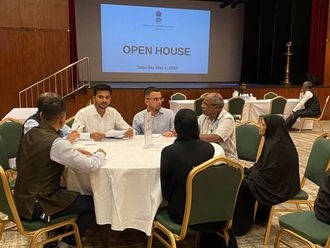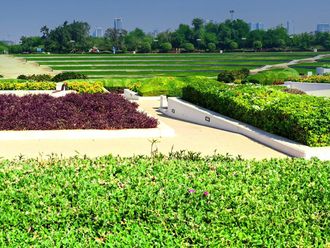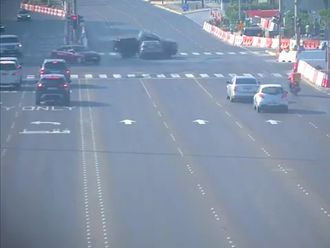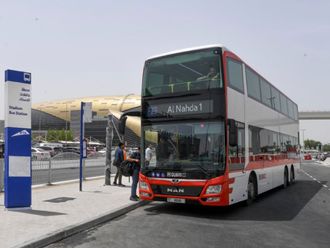Saif Ahmed Belhasa.©Gulf News |
So, what do you need to fine-tune your driving techniques and put yourself a step ahead of the others? One answer could be the Defensive Driving Course, newly introduced in the UAE.
According to Saif Ahmed Belhasa, managing director of Emirates Driving Institute, where the course is conducted, defensive driving is all about being alert and aware of road conditions. This will safeguard the driver from potential road hazards, getting stuck in traffic jams or even avoiding an accident.
"The course (which is accredited by the Institute of the Motor Industry (UK), and The Association of Driver Education, Germany), is about reminding one of the general rules, and training one to take sensible decisions behind the wheel. Around 95 per cent of all traffic accidents are the direct result of driver error. The safety of the public and loved ones lies in the hands of the driver, be it a private vehicle, a school bus or a taxi. The better they control their vehicle and road space, the safer everyone will be."
Saif Ahmed, along with Stephen Munn, technical advisor at Emirates Driving Institute, who coordinates the team of trained instructors in the Advanced Driving Wing, answer a few question on what defensive driving is all about.
First, what is defensive driving?
Defensive driving is driving in such a manner so as to avoid the 95 per cent of preventable accidents that are caused by the actions of other drivers. Most of these actions are taken with total disregard to the safety of other road users. This course teaches a driver how to safeguard his life and the lives of those around him. He will save time and repair costs by avoiding accidents. Driving will become a pleasure rather than an unavoidable task.
What are its objectives?
At the end of the course, drivers would be able to demonstrate their ability to apply total all-round observation; evaluate traffic hazards by 'reading' the road; understand the difference between a potential and an actual hazard; and react to and avoid potential incidents in a controlled manner
To qualify for this course, you should be a licensed driver who has been driving for at least six months to a year.
What is the duration of the course?
The participant has a choice of either a one-day or a two-day course. The former is basically a refresher course while the latter is a full course. Participants are assessed when they start the course, and, at the end of the course, they are given a final assessment, which they have to pass. Only then are they awarded a certificate.
Aren't two days too short a time to teach drivers these skills?
In this course, we do not teach candidates to drive. We only refine their driving skills so that they are not only confident in handling the car, but can also respond quickly to road and traffic conditions.
How would a defensive driver use his skills on the road?
First, the defensive driver would always be concentrating on the road and traffic situations. The training will allow him or her not to take any road situation for granted, and be prepared for any changes in road, traffic or weather conditions. During the course, drivers are assessed on driving skills, and notes are made of areas where individuals may require focused attention.
One of the first techniques they are taught is how to observe the road and traffic conditions correctly depending on speed and traffic volume. If they are observing correctly and seeing the big picture, they will recognise hazards early and have the time to react in a controlled manner.
Once the lectures are over, they are taken right into the hub of traffic in the city to apply the techniques taught in the classroom in a real-life situation. The course is not about driving fast, it's about driving safely.Ê
So, how would a defensive driver act at any given situation on the busy road?
One of the most common scenes one sees on busy roads is impatient drivers who change lanes indiscriminately. These actions cause many accidents, but they can be avoided if we use our observation skills correctly.
The defensive driver not only uses his centreline and wing mirrors, but turns his head to check his 'blind spot'. How can we see vehicles in this position? Simply by turning our head and looking over our shoulders. This check is one that the defensive driver will do every time before he moves his vehicle.
He is also made aware of the 'Circle of Safety' during his training, that is, making enough space between his car and others around him, so as to give him enough road space to avoid any accident. One also sees show-off drivers on the road, trying to get one up on other drivers. The defensive driver is able to spot and plan ahead and not be a scapegoat for him.
Tailgating is yet another common irritant on the roads, with drivers following too close to the car in front. In case of a hazard, this allows no reaction time, and the car is sure to bump into the one in front. A defensive driver would follow the '2-second' rule, where there is a 2-second space between himself and the car in front of him. He identifies this with a stationery object, for instance, a lamp post.
After the car in front of him passes the post, he counts two seconds. If he finishes the count before he passes the lamp post, then he is travelling at the right distance. If he is still counting as he passes the lamp post then he is travelling too close, and should slow down slightly to increase the gap.
When would a defensive driver make a decision to change position on the road?
His decision to act would be based on three factors:
a. what do I see?
This is the obvious - the condition of the road, how close the traffic is all around, and potential hazard as in a traffic jam, a wayside accident, etc. While most drivers act only when the problem occurs, the defensive driver is able to spot the problem before it occurs and plan ahead.
b. What don't I see?
This applies when the driver experiences a loss of sightline, in other words, when something is blocking his vision of the road ahead, e.g. a bend in the road, brow of a hill or a heavy vehicle in front of him. He has to prepare to slow down, perhaps move out a little to get a better view.
c. What don't I know?
This element deals with the unpredictability of other drivers: has the other driver seen the problem? Is he going to react late? How will he react? How will it affect me?... basicallyÊ imagining all the different scenarios possible to protect ourselves and our passengers. By considering these three questions, the defensive driver will be looking at the big picture.
A few s











